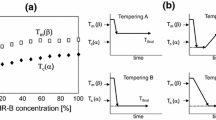Conclusions
Data obtained on the solubility of hydrogenated peanut oil in refined peanut oil and the behavior of the mixtures on cooling indicate that freedom from oil separation on storage is largely determined by the nature as well as the amount of solid crystals present in the oil. The results suggest that the best procedure for prevention of oil separation would involve shockchilling the molten mixture to produce the finely divided metastable crystalline modification followed by tempering at such a temperature as to permit transformation of the crystals into the more desirable higher-melting form without changing the finely divided state necessary for improved palatability.
The data imply that under controlled conditions any amount of the high-melting modification of the hard fat incorporated in peanut oil above the solubility temperature in excess of 2% should produce a mixture free from oil separation under average storage conditions. The choice of the actual concentration of the hard fat, above the minimum amount, would depend upon the degree of plasticity desired. Ambient temperature to which the mixture is likely to be subjected will influence to a considerable extent the selection of the hard fat content. The information obtained is of fundamental importance in connection with the problem of oil separation in peanut butter.
Similar content being viewed by others
References
Bailey, A. E., “Industrial Oil and Fat Products,” 2nd ed., Interscience Publishers Inc., New York, N. Y. (1951); pp. 210–216;
—— pp. 215–216;
—— p. 218;
—— p. 277.
Bailey, A. E., “Melting and Solidification of Fats,” Interscience Publishers Inc., New York, N. Y. (1950); a) pp. 22–23;
—— p. 291;
—— p. 305.
Freeman, A. F., and Singleton, W. S., Peanut Journal and Nut World,31, (4), 23 (1952).
Hofgaard, K., “Dilatometriske Fedtstof-Undersøgelser,” Dissertation, Danmarks Tekniske Højskole, G. E. C. Gad Forlag, Copenhagen, 1938, Table 40.
Holman, George W., and Quimby, Oscar T. (to the Procter and Gamble Company), U. S. Patent 2,521,219 (September 5, 1950).
Magne, F. C., and Skau, E. L., J. Am. Chem. Soc.,74, 2628 (1952).
Mitchell, P. J. Jr., U. S. Patent 2,562,630 (July 31, 1951).
Singleton, W. S., and Freeman, A. F., Food Research,15, 297 (1950).
Stockton, Frank Webb, U. S. Patent 1,395,934 (November 1, 1921).
Author information
Authors and Affiliations
Additional information
One of the laboratories of the Bureau of Agricultural and Industrial Chemistry, Agricultural Research Administration, U. S. Department of Agriculture.
About this article
Cite this article
Magne, F.C., Skau, E.L. & Freeman, A.F. Solubility of hydrogenated peanut oil in peanut oil. J Am Oil Chem Soc 31, 113–114 (1954). https://doi.org/10.1007/BF02612496
Received:
Issue Date:
DOI: https://doi.org/10.1007/BF02612496




